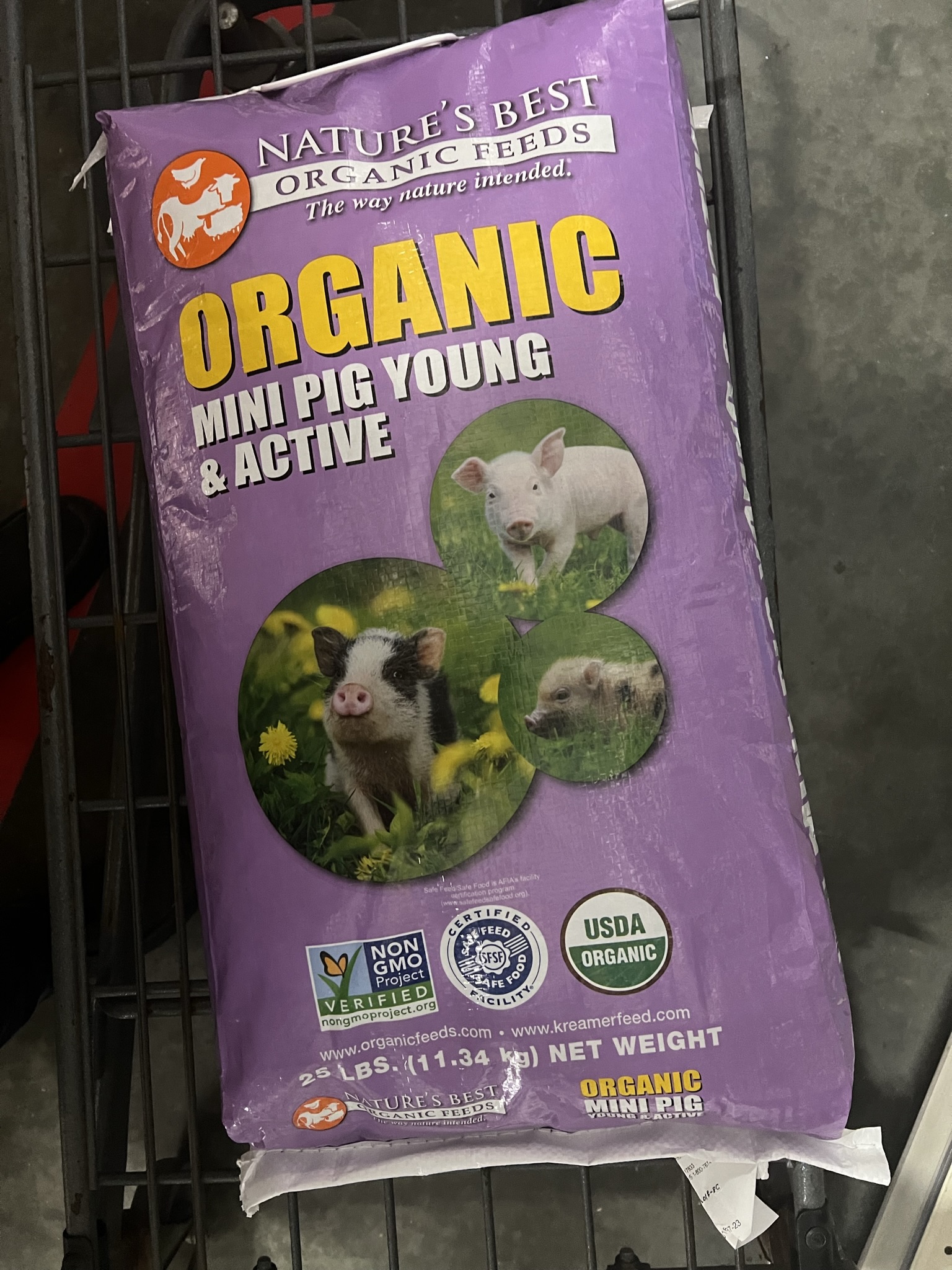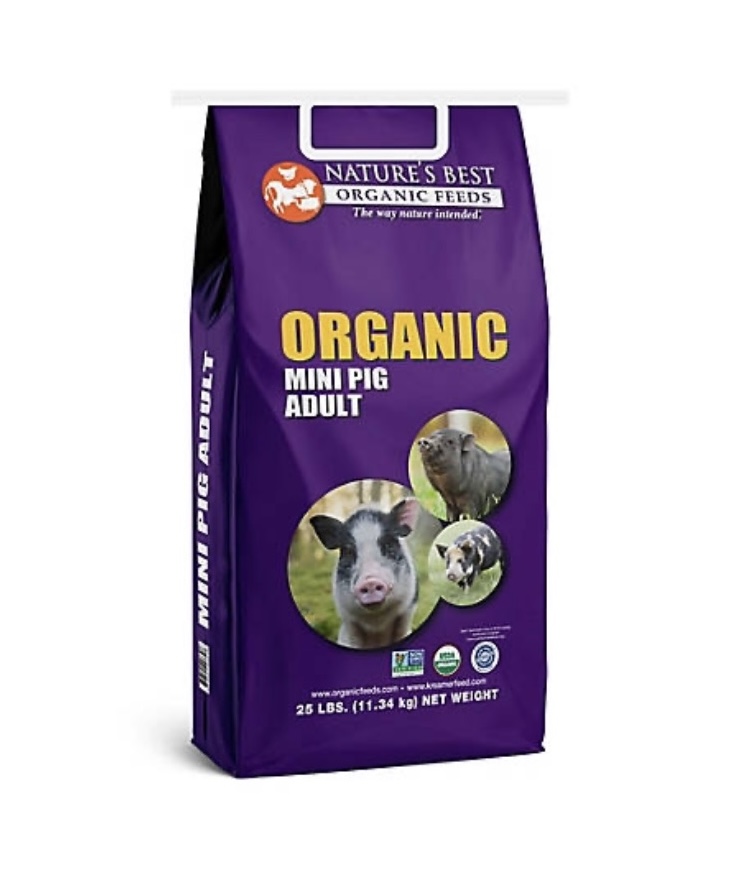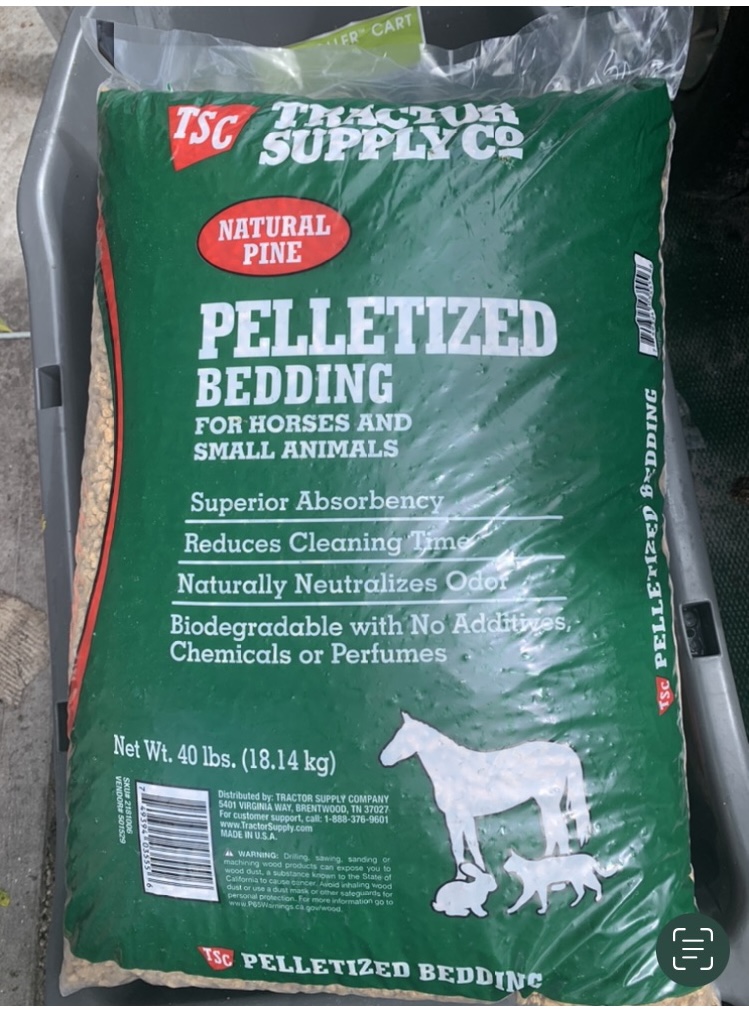


These can be found at Tractor Supply & Rural King-type stores.
How to take care of a teacup pig
Here is the big question. What do I feed my pig and how much?
I recommend feeling Nature’s Best Organic Feeds, Mazuri mini Pig food, or Purina Sow and Pig which can be found at Tractor Supply or the Mazuri Site.
How much to feed:
Mazuri recommends feeding your piglet 1-3% of its weight daily. If your piglet is 5 lbs then it would be 80 oz of body weight so 1% will equal .80 which is a little over 1/2 oz, 2% will equal 1.6 oz, and 3% will equal 2.4 oz, divided between two meals a day. This is not much when you look at it but it is not starving your baby, This is the amount that scientists have determined is the correct amount to feed your piglet so that it remains healthy and not overweight. Not only does feeding too much cause your piglet to get bigger than you want but can shorten its life, aggravate arthritis, and even cause it to be blind.
Pig Weight 1% of Body Weight 2% of Body Weight
Pounds Tbsp./Cups Tbsp./Cups
2 1 Tbsp. 1 2/3 Tbsp.
5 2 Tbsp. 4 Tbsp.
10 ¼ Cup ½ Cup
20 ½ Cup 1 Cup
30 ¾ Cup 1 2/3 Cup
40 1 Cup 2 ¼ Cup
50 1 1/3 Cup 2 2/3 Cup
60 1 2/3 Cup 3 ¼ Cup
70 2 Cups 3 ¾ Cup
80 2 ¼ Cup 4 ¼ Cup
90 2 1/3 Cup 4 ¾ Cup
100 2 2/3 Cup 5 1/3 Cup
If your piglet is inside most of the time I would recommend the Elder as it has fewer calories.
The best way to determine whether to feed 1-2% would be to monitor your piglet’s shape. Start at 2% and if your piglets get fat around the neck area back off the feed. If its hips are bony like an old cow then increase its feed.
Treats and Snacks for Mini Pigs
What about treats? Yes, you can feed your baby treats. Healthy treats! The kind you would eat if you were on a diet. Lettuce, cucumbers, carrots, raw squash. You can give them cabbage which is cheap and they love it but BEWARE pig poots will run you out of the room! Preferably fresh but frozen will be ok. make your piglet earn its treats by learning tricks. Do not give your pig salt. Pigs are not salt-tolerant and it can cause them to have seizures and die if they get too much. Like dogs, chocolate is off the list as well.
Healthy Treat Ideas
**NUTS & SEEDS– UNSALTED**
Almonds
Cashews
Brazil nuts
Hazelnuts
Peanuts
Pecans
Walnuts
Sunflower seeds / black oil sunflower seeds
Quinoa
Hemp hearts/hemp seeds
Pumpkin seeds
Chia seeds
Sesame seeds
Pomegranate seeds
Cumin seeds
Grape seeds
**GRAINS**
Amaranth
Oats / Oatmeal
Barley
Sorghum / Milo
Freekah
Millet
Spelt
Wheat Berries
Farro
Barley
Rye
Bulgar
Teff
Brown Rice
Wheat Germ
**OTHER HEALTHY SNACKS AND OCCASIONAL TREATS**
Yogurt
Applesauce no sugar added
Canned pumpkin (100% pumpkin! not pie filling)
Cereal: Cheerios, puffed rice, puffed wheat, shredded wheat
Coconut water
Coconut oil
Cottage cheese
Eggs
Fruit juice no sugar added
Granola
Popcorn, air-popped with no oils or salt
Peanut butter
Cooked lentils and other beans (not canned)
Raisins- sparingly as they are sticky and not good for dental health
**VEGETABLES AND HEALTHY GREENS**
ALL summer & winter squash (some are repeated in this list, sorry)
Acorn Squash
Amaranth
Arrowroot
Artichoke
Arugula
Asparagus
Banana Squash
Beets
Belgian Endive
Bell Peppers
Black Eyed Peas
Black olives (fed sparingly due to sodium content)
Black Radish
Black Salsify
Bok choy
Broccoli
Brussels sprouts
Burdock Root
Butter Lettuce
Buttercup Squash
Butternut Squash
Cabbage & red cabbage
Carrots
Cauliflower
Celery Root
Celery
Chayote Squash
Cherry Tomatoes
Chickweed
Chives
Collard greens
Corn (sparingly, there’s enough corn in their pellets already)
Cucumbers
Dandelion flower and leaves
Eggplant
Endive
Fava Beans
Fennel
Galangal Root
Green Beans
Green leaf lettuce
Green Soybeans (Edamame)
Jicama
Kale
Kohlrabi
Leeks
Lettuce
Lima Beans
Manoa
Lettuce
Mushrooms
Mustard Greens
Okra
Olives
Parsnips
Pea Pods
Peanuts (unsalted)
Peas Plantain
Pumpkin
Purple Asparagus
Radicchio
Radishes & leaves
Red clover
Red Leaf Lettuce
Rhubarb stem/stalk (the leaves are poisonous and should not be fed)
Romaine lettuce
Rutabagas
Shallots
Snow Peas
Sorrel
Spinach
Spring Baby Lettuce
Sugar Snap Peas
Sweet Dumpling Squash
Sweet Potatoes
Swiss chard
Tomatoes (tomatoes are good but the plant and leaves are poisonous and should not be fed)
Turnip greens
Turnips
Wasabi Root
Watercress
Winged Beans
Winter Squash
Yellow Squash
Yucca Root
Zucchini
**FRUITS- FED SPARINGLY DUE TO SUGAR CONTENT**
Apples NO SEEDS
Apricots NO PITS
Bananas & peels
Bitter Melon
Black Currants
Blackberries
Blueberries
Boysenberries
Breadfruit
Cactus Pear
Cantaloupe
Cape Gooseberries
Cherimoya
Cherries NO PITS
Clementines
Coconut
Crab Apples
Cranberries fresh or dried
Dates
Durian
Elderberries
Feijoa
Figs
Grapefruit
Grapes, cut in half or quarter too prevent choking
Guava
Honeydew Melon
Huckleberries
Jackfruit
Jujube
Kiwi & peels
Kumquats
Lemons
Limes
Loganberries
Lychee
Mango
Mulberries
Nectarines (NO PITS)
Olallie berries
Oranges
Papayas
Passion Fruit
Peaches NO PITS
Pears NO PITS
Persimmons
Plums NO PITS
Pomegranate
Pummelo
Quince
Raspberries
Red Banana
Red Currants